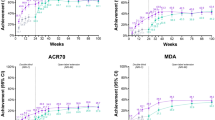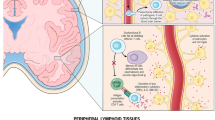Abstract
Lack of sufficient head-to-head trials comparing biologic disease-modifying antirheumatic drugs (bDMARDs) in rheumatoid arthritis (RA), makes the choice of the first bDMARD a matter of rheumatologist’s preference. Longer drug survival on the first bDMARD usually correlates with early remission. We aimed to identify factors associated with longer drug survival. We conducted a population-based retrospective longitudinal cohort study. We identified RA patients using the relevant International Classification of Disease 9th codes. “True” RA patients were defined as patients fulfilling, additionally, at least one of the following: receiving conventional DMARDs (cDMARDs), being positive for rheumatoid factor or anti-cyclic citrullinated peptide, or being diagnosed by a rheumatologist. We compared drug survival times and identified factors associated with longer drug survival. We identified 4268 true RA patients between the years of 2000–2017. 820 patients (19.2%) received at least one bDMARD. The most commonly prescribed bDMARDs were etanercept (352, 42.9%), adalimumab (143, 17.4%), infliximab (142, 17.3%) and tocilizumab (58, 7.1%). Infliximab was associated with the longest drug survival (47.1 months ± 46.3) while golimumab was associated with the shortest drug survival (14.9 months ± 15.1). Male gender [hazard ratio (HR) = 0.76, 95% confidence interval (CI), 0.63–0.86, p = 0.001], concurrent conventional DMARDs use (HR = 0.79, 95% CI 0.68 – 0.98, p = .031) and initiating bDMARD therapy in earlier calendric years (HR = 1.12, 95% CI 1.10 –1.18, p = 0.0001) were associated with longer drug survival. Male gender, concomitant cDMARDs and initiating biologic therapy at earlier calendric years are associated with longer drug survival.


Similar content being viewed by others
Availability of data and material
Data were obtained from the Leumit Health Services. The datasets generated during and/or analysed during the current study are not publicly available due to the Leumit Health Services policy.
References
Myasoedova E, Crowson CS, Kremers HM, Therneau TM, Gabriel SE (2010) Is the incidence of rheumatoid arthritis rising? results from Olmsted County, Minnesota, 1955–2007. Arthritis Rheum 62(6):1576–1582
Burmester GR, Pope JE (2017) Novel treatment strategies in rheumatoid arthritis. Lancet 389(10086):2338–2348
Smolen JS, Breedveld FC, Burmester GR et al (2016) Treating rheumatoid arthritis to target: 2014 update of the recommendations of an international task force. Ann Rheum Dis 75(1):3–15
Chatzidionysiou K, Sfikakis PP (2019) Low rates of remission with methotrexate monotherapy in rheumatoid arthritis: Review of randomised controlled trials could point towards a paradigm shift. RMD Open. https://doi.org/10.1136/rmdopen-2019-000993
Armagan B, Sari A, Erden A, Kilic L, Erdat EC, Kilickap S, Kiraz S, Bilgen SA, Karadag O, Akdogan A, Ertenli I, Kalyoncu U (2018) Starting of biological disease modifying antirheumatic drugs may be postponed in rheumatoid arthritis patients with multimorbidity. Medicine. https://doi.org/10.1097/MD.0000000000009930
Smolen JS, Landewé R, Bijlsma J et al (2017) EULAR recommendations for the management of rheumatoid arthritis with synthetic and biological disease-modifying antirheumatic drugs: 2016 update. Ann Rheum Dis 76(6):960–977
Jin Y, Desai RJ, Liu J, Choi NK, Kim SC (2017) Factors associated with initial or subsequent choice of biologic disease-modifying antirheumatic drugs for treatment of rheumatoid arthritis. Arthritis Res Ther 19(1):159
Burgos PI, Danila MI, Kelley JM, Hughes LB, Bridges SL (2009) Understanding personalized medicine in rheumatoid arthritis: a clinician’s guide to the future. Ther Adv Musculoskelet Dis 1(2):97–105
Bluett J, Barton A (2017) Precision medicine in rheumatoid arthritis. Rheum Dis Clin North Am 43(3):377–387
Liu C, Batliwalla F, Li W et al (2008) Genome-wide association scan identifies candidate polymorphisms associated with differential response to anti-TNF treatment in rheumatoid arthritis. Mol Med 14(9–10):575–581
Krintel SB, Palermo G, Johansen JS et al (2012) Investigation of single nucleotide polymorphisms and biological pathways associated with response to TNFα inhibitors in patients with rheumatoid arthritis. Pharmacogenet Genomics 22(8):577–589
Plant D, Bowes J, Potter C et al (2011) Genome-wide association study of genetic predictors of anti-tumor necrosis factor treatment efficacy in rheumatoid arthritis identifies associations with polymorphisms at seven loci. Arthritis Rheum 63(3):645–653
Mirkov MU, Cui J, Vermeulen SH et al (2013) Genome-wide association analysis of anti-TNF drug response in patients with rheumatoid arthritis. Ann Rheum Dis 72(8):1375–1381
Costa FF (2014) Big data in biomedicine. Drug Discov Today 19(4):433–440
DeWitt EM, Lin L, Glick HA, Anstrom KJ, Schulman KA, Reed SD (2009) Pattern and predictors of the initiation of biologic agents for the treatment of rheumatoid arthritis in the United States: an analysis using a large observational data bank. Clin Ther 31(8):1871–1880
Kim G, Barner JC, Rascati K, Richards K (2015) Factors associated with the initiation of biologic disease-modifying antirheumatic drugs in Texas medicaid patients with rheumatoid arthritis. J Manag Care Spec Pharm 21(5):401–407
Pasma A, van’tSpijker A, Hazes JMW, Busschbach JJV, Luime JJ (2013) Factors associated with adherence to pharmaceutical treatment for rheumatoid arthritis patients: a systematic review. Semin Arthritis Rheum 43(1):18–28
Desai RJ, Rao JK, Hansen RA, Fang G, Maciejewski ML, Farley JF (2014) Predictors of treatment initiation with tumor necrosis factor-A inhibitors in patients with rheumatoid arthritis. J Manag Care Spec Pharm 20(11):1110–1120
Neubauer S, Cifaldi M, Mittendorf T, Ganguli A, Wolff M, Zeidler J (2014) Biologic TNF inhibiting agents for treatment of rheumatoid arthritis: persistence and dosing patterns in Germany. Health Econ Rev 4(1):32
Mahlich J, Sruamsiri R (2016) Persistence with biologic agents for the treatment of rheumatoid arthritis in Japan. Patient Prefer Adherence 5(10):1509–1519
Yelin E, Tonner C, Kim SC et al (2014) Sociodemographic, disease, health system, and contextual factors affecting the initiation of biologic agents in rheumatoid arthritis: A longitudinal study. Arthritis Care Res (Hoboken) 66(7):980–989
Reges O, Greenland P, Dicker D et al (2018) Association of bariatric surgery using laparoscopic banding, roux-en-y gastric bypass, or laparoscopic sleeve gastrectomy vs usual care obesity management with all-cause mortality. JAMA 319(3):279–290
Rennert G, Peterburg Y (2001) Prevalence of selected chronic diseases in Israel. Isr Med Assoc J 3(6):404–408
Pringle M, Ward P, Chilvers C (1995) Assessment of the completeness and accuracy of computer medical records in four practices committed to recording data on computer. Br J Gen Pract 45:537–541
Shalev V, Chodick G, Goren I, Silber H, Kokia E, Heymann AD (2011) The use of an automated patient registry to manage and monitor cardiovascular conditions and related outcomes in a large health organization. Int J Cardiol 152(3):345–349
Orr CK, Najm A, Young F et al (2018) The utility and limitations of CRP, ESR and DAS28-CRP in appraising disease activity in rheumatoid arthritis. Front Med 5:185
Silvagni E, Bortoluzzi A, Carrara G, Zanetti A, Govoni M, Scirè CA (2018) Comparative effectiveness of first-line biological monotherapy use in rheumatoid arthritis: A retrospective analysis of the RECord-linkage on rheumatic diseases study on health care administrative databases. BMJ Open. https://doi.org/10.1136/bmjopen-2017-021447
St.Clair EW, VanDerHeijde DMFM, Smolen JS et al (2004) Combination of infliximab and methotrexate therapy for early rheumatoid arthritis: A randomized, controlled trial. Arthritis Rheum 50(11):3432–3443
Maini RN, Breedveld FC, Kalden JR et al (1998) Therapeutic efficacy of multiple intravenous infusions of anti-tumor necrosis factor monoclonal antibody combined with low-dose weekly methotrexate in rheumatoid arthritis. Arthritis Rheum 41(9):1552–1563
Fleischmann R, Mysler E, Hall S et al (2017) Efficacy and safety of tofacitinib monotherapy, tofacitinib with methotrexate, and adalimumab with methotrexate in patients with rheumatoid arthritis (ORAL Strategy): a phase 3b/4, double-blind, head-to-head, randomised controlled trial. Lancet 390(10093):457–468
Breedveld FC, Weisman MH, Kavanaugh AF et al (2006) The PREMIER study: A multicenter, randomized, double-blind clinical trial of combination therapy with adalimumab plus methotrexate versus methotrexate alone or adalimumab alone in patients with early, aggressive rheumatoid arthritis who had not had previous methotrexate treatment. Arthritis Rheum 54(1):26–37
Van Der Heijde D, Klareskog L, Rodriguez-Valverde V et al (2006) Comparison of etanercept and methotrexate, alone and combined, in the treatment of rheumatoid arthritis: Two-year clinical and radiographic results from the TEMPO study, a double-blind, randomized trial. Arthritis Rheum 54(4):1063–1074
Emery P, Burmester GR, Bykerk VP et al (2015) Evaluating drug-free remission with abatacept in early rheumatoid arthritis: Results from the phase 3b, multicentre, randomised, active-controlled AVERT study of 24 months, with a 12 month, double-blind treatment period. Ann Rheum Dis 74(1):19–26
Mariette X, Gottenberg JE, Ravaud P, Combe B (2011) Registries in rheumatoid arthritis and autoimmune diseases: Data from the French registries. Rheumatology (Oxford) 50(1):222–229
Krieckaert CL, Bartelds GM, Lems WF, Wolbink GJ (2010) The effect of immunomodulators on the immunogenicity of TNF-blocking therapeutic monoclonal antibodies: a review. Arthritis Res Ther 12(5):217
Ngo ST, Steyn FJ, McCombe PA (2014) Gender differences in autoimmune disease. Front Neuroendocrinol Front Neuroendocrinol 35(3):347–369
Favalli EG, Biggioggero M, Crotti C, Becciolini A, Raimondo MG, Meroni PL (2019) Sex and Management of Rheumatoid Arthritis. Clin Rev Allergy Immunol 56(3):333–345
Wolfe F, Michaud K (2004) Severe rheumatoid arthritis (RA), worse outcomes, comorbid illness, and sociodemographic disadvantage characterize RA patients with fibromyalgia. J Rheumatol 31(4):695–700
Yu C, Jin S, Wang Y et al (2019) Remission rate and predictors of remission in patients with rheumatoid arthritis under treat-to-target strategy in real-world studies: a systematic review and meta-analysis. Clin Rheumatol 38(3):727–738
Haraoui B, Bensen W, Thorne C et al (2014) Treating rheumatoid arthritis to target: a Canadian patient survey. J Clin Rheumatol 20(2):61–67
Smolen JS, Aletaha D, Bijlsma JWJ et al (2010) Treating rheumatoid arthritis to target: recommendations of an international task force. Ann Rheum Dis 69(4):631–637
Dagliati A, Plant D, Nair N et al (2020) Latent class trajectory modeling of 2-component disease activity score in 28 joints identifies multiple rheumatoid arthritis phenotypes of response to biologic disease-modifying antirheumatic drugs. Arthritis Rheumatol 72(10):1632–1642
Siemons L, Ten Klooster PM, Vonkeman HE, Glas CAW, Van De Laar MAFJ (2014) Distinct trajectories of disease activity over the first year in early rheumatoid arthritis patients following a treat-to-target strategy. Arthritis Care Res (Hoboken) 66(4):625–630
Courvoisier DS, Alpizar-Rodriguez D, Gottenberg JE et al (2016) Rheumatoid arthritis patients after initiation of a new biologic agent: trajectories of disease activity in a large multinational cohort study. EBioMedicine 11:302–306
Salgado E, Maneiro JR, Carmona L, Gómez-Reino J (2014) Rheumatoid factor and response to TNF antagonists in rheumatoid arthritis: systematic review and meta-analysis of observational studies. Joint Bone Spine 81(1):41–50
Treharne GJ, Lyons AC, Kitas GD (2004) Medication adherence in rheumatoid arthritis: effects of psychosocial factors. Psychol Health Med 93:337–349
Acknowledgements
Thanks to Naama Hayman Brisk for her help in retrieving and processing the data.
Funding
The authors did not receive any funding.
Author information
Authors and Affiliations
Corresponding author
Ethics declarations
Conflict of interest
The authors have no conflict of interests to declare.
Ethical approval
Ethical approval for this study was obtained from the Galilee Medical Center.
Additional information
Publisher's Note
Springer Nature remains neutral with regard to jurisdictional claims in published maps and institutional affiliations.
Rights and permissions
About this article
Cite this article
Naffaa, M.E., Hassan, F., Golan-Cohen, A. et al. Factors associated with drug survival on first biologic therapy in patients with rheumatoid arthritis: a population-based cohort study. Rheumatol Int 41, 1905–1913 (2021). https://doi.org/10.1007/s00296-021-04989-y
Received:
Accepted:
Published:
Issue Date:
DOI: https://doi.org/10.1007/s00296-021-04989-y




